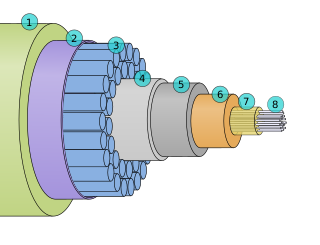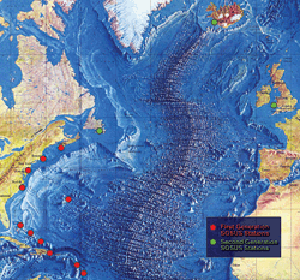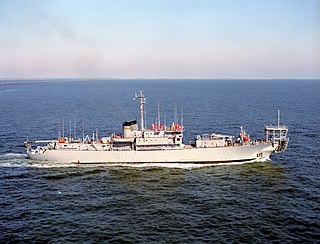Related Research Articles
TAT-8 was the 8th transatlantic communications cable and first transatlantic fiber-optic cable, carrying 280 Mbit/s between the United States, United Kingdom and France. It was constructed in 1988 by a consortium of companies led by AT&T Corporation, France Télécom, and British Telecom. AT&T Bell Laboratories developed the technologies used in the cable. The system was made possible by optical amplifiers acting as repeaters with advantages over the electrical repeaters of former cables. They were less costly and could be at greater spacing with less need for associated hardware and software. It was able to serve the three countries with a single transatlantic crossing with the use of an innovative branching unit located underwater on the continental shelf off the coast of Great Britain. The cable lands in Tuckerton, New Jersey, USA, Widemouth Bay, England, UK, and Penmarch, France.
CANTAT-1 was the first Canadian transatlantic telephone cable, between Hampden, Newfoundland and eventually Grosses-Roches, Quebec and Oban, United Kingdom, which followed on from the success of TAT-1. It was conceived and approved as stage one of a proposed commonwealth round the world cable and was done at a cost of $8,500,000. The system was jointly owned by Cable & Wireless and the Canadian Overseas Telecommunication Corporation (COTC).

A submarine communications cable is a cable laid on the sea bed between land-based stations to carry telecommunication signals across stretches of ocean and sea. The first submarine communications cables laid beginning in the 1850s carried telegraphy traffic, establishing the first instant telecommunications links between continents, such as the first transatlantic telegraph cable which became operational on 16 August 1858. Subsequent generations of cables carried telephone traffic, then data communications traffic. Modern cables use optical fibre technology to carry digital data, which includes telephone, Internet and private data traffic.

The Sound Surveillance System (SOSUS) was a passive sonar system developed by the United States Navy to track Soviet submarines. The system's true nature was classified with the name and acronym SOSUS themselves classified. The unclassified name Project Caesar was used to cover the installation of the system and a cover story developed regarding the shore stations, identified only as a Naval Facility (NAVFAC), being for oceanographic research. In 1985, as the fixed bottom arrays were supplemented by the mobile Surveillance Towed Array Sensor System (SURTASS) and other new systems were coming on line, the name itself changed to Integrated Undersea Surveillance System (IUSS). The commands and personnel were covered by the "oceanographic" term until 1991 when the mission was declassified. As a result, the commands, Oceanographic System Atlantic and Oceanographic System Pacific became Undersea Surveillance Atlantic and Undersea Surveillance Pacific, and personnel were able to wear insignia reflecting the mission.

A deep-submergence vehicle (DSV) is a deep-diving crewed submersible that is self-propelled. Several navies operate vehicles that can be accurately described as DSVs. DSVs are commonly divided into two types: research DSVs, which are used for exploration and surveying, and DSRVs, which can be used for rescuing the crew of a sunken navy submarine, clandestine (espionage) missions, or both. DSRVs are equipped with docking chambers to allow personnel ingress and egress via a manhole.

A cable layer or cable ship is a deep-sea vessel designed and used to lay underwater cables for telecommunications, electric power transmission, military, or other purposes. Cable ships are distinguished by large cable sheaves for guiding cable over bow or stern or both. Bow sheaves, some very large, were characteristic of all cable ships in the past, but newer ships are tending toward having stern sheaves only, as seen in the photo of CS Cable Innovator at the Port of Astoria on this page. The names of cable ships are often preceded by "C.S." as in CS Long Lines.

Underwater habitats are underwater structures in which people can live for extended periods and carry out most of the basic human functions of a 24-hour day, such as working, resting, eating, attending to personal hygiene, and sleeping. In this context, 'habitat' is generally used in a narrow sense to mean the interior and immediate exterior of the structure and its fixtures, but not its surrounding marine environment. Most early underwater habitats lacked regenerative systems for air, water, food, electricity, and other resources. However, some underwater habitats allow for these resources to be delivered using pipes, or generated within the habitat, rather than manually delivered.
CANTAT is an acronym for Canada TransAtlantic Telephone Cable, a series of submarine communications cable systems linking Canada with the U.K. and later Europe. The first cable was a joint venture of Cable & Wireless and the Canadian Overseas Telecommunications Corporation (COTC) implementing national policies to establish a Commonwealth Round the World Cable System. The name has been applied to three systems.
The second CS Faraday was a cable ship built by Palmers Shipbuilding and Iron Company, Hebburn-on-Tyne, in 1922–23, as a replacement for the ageing CS Faraday built in 1874. Design of the new ship was influenced by long experience with the original ship.

USNS Albert J. Myer (T-ARC-6) was the second of only two Maritime Commission type S3-S2-BP1 ships built for the US Army near the end of World War II intended to support Army Signal Corps communications cables. She is named for Brig. Gen. Albert J. Myer, the founder of the Signal Corps. The other ship was the William H. G. Bullard, later USS Neptune, which Myer later joined in naval service.

USS Kailua (IX-71) was originally CS Dickenson, a civilian supply and personnel transport cable-repair ship of the Commercial Pacific Cable Company that was based in Honolulu serving the island cable stations at Midway and Fanning Island.

The Hawaii Undersea Research Laboratory (HURL) is a regional undersea research program within the School of Ocean and Earth Sciences and Technology (SOEST) at University of Hawaii at Manoa, in Honolulu. It is considered one of the more important of the independently run undersea research laboratories in the U.S. HURL operates two deep diving submersibles, the Pisces IV and Pisces V and specializes in supporting scientific ocean research and exploration. HURL is actively involved in monitoring deep-sea ecosystems, including coral habitats and fisheries, and conducts maritime archaeology research including documenting World War II wreckage from the Attack on Pearl Harbor in 1941.

Pisces class submersibles are three person research deep-submergence vehicles designed and built by Hyco International Hydrodynamics of North Vancouver in British Columbia with a maximum operating depth of 2,000 m (6,560 ft). The vehicles have multiple view ports, sample collecting, environmental sensing, and instrument placement capabilities. The pressure hull has a 7 ft (2.1 m) inside diameter and is made of HY-100 steel with 3 forward-looking acrylic windows, 6 in (15 cm) in diameter. Designed by Allan Trice, the Pisces series of submersibles are representative of early manned submersibles built in the late 1960s and were proven workhorses in offshore exploration and oceanographic research. Pisces II was the first production model of the design and was completed in 1968, with 9 more Pisces subs built before the manufacturer folded in the late 1970s.
Cable & Wireless Communications Ltd operating as C&W Communications is a telecommunications company which has operations in the Caribbean and Central America. It is owned by Liberty Latin America and is headquartered in Denver, Colorado.

Pisces IV is a three-person, battery-powered Deep Submergence Vehicle, with a maximum operating depth of 2,000 m (6,600 ft). The craft was built by Hyco International Hydrodynamics in Vancouver, and is currently owned by the Hawaii Undersea Research Laboratory arm of the National Oceanic and Atmospheric Administration. It and its sister, Pisces V, are Pisces class submersibles used by the NOAA for oceanic exploration.

CURV-III was the fourth generation of the United States Navy Cable-controlled Undersea Recovery Vehicle (CURV). CURV was a prototype for remotely operated underwater vehicles and a pioneer for teleoperation. It became famous in 1966 when CURV-I was used to recover a hydrogen bomb from the floor of the Mediterranean Sea. In 1973, CURV-III performed the deepest underwater rescue in history when it rescued two men 1,575 feet (480 m) from the ocean surface who were stranded 76 hours in the submersible Pisces III with just minutes of air remaining. The CURV-III became known in the Great Lakes region in 1976 when it was used to survey the wreck of the SS Edmund Fitzgerald. CURV-21 is the current generation that replaced CURV-III.
Joseph Beverly MacInnis is a Canadian physician, author, and diver. In 1974, MacInnis was the first scientist to dive in the near-freezing waters beneath the North Pole. In 1976 he became a member of the Order of Canada.

The rescue of Roger Mallinson and Roger Chapman occurred between 29 August and 1 September 1973 after their Vickers Oceanics small submersible Pisces III was trapped on the seabed at a depth of 1,575 ft (480 m), 150 mi (240 km) off Ireland in the Celtic Sea. The 76-hour multinational rescue effort resulted in the deepest sub rescue in history.

Naval Facility Point Sur was one of 30 secret sites worldwide that were built during the Cold War to detect Soviet submarines. In 1958, the U.S. Navy built a Naval Facility (NAVFAC) ½ mile south of Point Sur on the Big Sur coast to provide submarine surveillance using the classified SOund SUrveillance System (SOSUS). The public was told the station was engaged in oceanographic research.
HMTS Monarch, launched on 8 August 1945 and completed during February 1946, was the fourth cable ship with that name. The ship was built for the General Post Office (GPO) for the laying and repair of submarine communications cable and was the largest cable ship in the world when completed and the first cable ship to have all electric cable machinery.
References
- ↑ Glover, Bill (5 March 2019). "History of the Atlantic Cable & Undersea Communications — Atlantic Cables: 1856-2018". History of the Atlantic Cable & Undersea Communications. Retrieved 2 February 2020.
- ↑ Pass, H. "The Sinking and Rescue of Pisces III" (PDF). The Seventh Undersea Medical Society Workshop — Medical Aspects of Small Submersible Operations 19—20 November 1974. Undersea Medical Society: II-11. Archived (PDF) from the original on February 2, 2020. Retrieved 2 February 2020.
- ↑ Scott, David (1974). "Way Out Machines Lay New High-Traffic Cable". Popular Science . Vol. 204, no. 1. Times Mirror Magazines. pp. 82–85. Retrieved 2 February 2020.